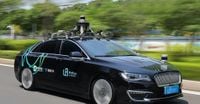China is tightening regulations on autonomous driving, imposing significant restrictions on key functions in a move that could reshape the future of the automotive industry. The Chinese Ministry of Industry and Information Technology (MIIT) announced new regulations aimed at enhancing safety and managing risks associated with autonomous vehicles. These measures come in response to rising concerns about the safety of Advanced Driver Assistance Systems (ADAS), particularly following a recent incident involving an electric vehicle.
Among the most notable changes is the prohibition of terms like "autonomous driving" and "intelligent driving" in car advertising. This decision reflects the government's effort to regulate how these technologies are marketed, ensuring that consumers have a clear understanding of their capabilities and limitations. The MIIT's announcement indicates a shift towards more stringent oversight in a sector that has been rapidly evolving.
In addition to banning certain terminology, the new regulations require car manufacturers to obtain government approval for remote software updates. These updates, which are crucial for enhancing vehicle performance and safety, must also undergo rigorous testing before they can be implemented. This measure aims to prevent potential risks that could arise from untested software changes.
Furthermore, functionalities such as automatic parking and remote vehicle control are now prohibited. The MIIT has deemed these features as unable to guarantee the driver's full attention and safety, reflecting a cautious approach to the integration of advanced technologies in everyday driving scenarios. The new rules also seek to limit the frequency of over-the-air software updates, with enhanced recall procedures for safety-critical updates.
This regulatory overhaul represents a significant shift for the Chinese automotive industry, which has been at the forefront of autonomous driving innovation. As the world's largest automotive market, China's approach to regulation will likely influence global standards and practices in the sector. The implications of these new rules could be far-reaching, potentially slowing the pace of development and deployment of autonomous driving technologies.
Meanwhile, in Italy, a groundbreaking test of fully autonomous driving took place on the Tangenziale di Napoli, one of the country's busiest and most symbolic roadways. A Maserati GranCabrio Folgore successfully demonstrated its autonomous capabilities over a three-kilometer stretch between the Vomero and Fuorigrotta exits. This test was not only a technological achievement but also a collaborative effort involving several key players, including the Smart Road Observatory of MIT, Autostrade per l’Italia, the Campania Traffic Police, and the Politecnico di Milano.
The primary goal of the test was to assess how well an autonomous vehicle could navigate the complex and often chaotic traffic conditions typical of the Tangenziale di Napoli. The Maserati was accompanied by vehicles from the Tangenziale di Napoli Spa, which were equipped with the innovative Car2x system, enabling direct communication with the highway infrastructure. This setup allowed for enhanced situational awareness and coordination between the vehicle and the surrounding environment.
While the Maserati operated autonomously, a trained pilot was present on board, ready to take control if necessary. This precaution underscores the importance of safety in autonomous driving tests, particularly in challenging urban settings. The successful navigation of the Maserati through the unpredictable traffic of Naples marks a significant milestone in the development of autonomous vehicles.
Additionally, this test also introduced a new feature called Dynamic Speed Limit, developed in collaboration with Movyon and the University of Naples Federico II. Unlike traditional speed limits, which remain fixed, the Dynamic Speed Limit system can adjust speed limits in real time based on traffic conditions detected by a control center. This innovative approach aims to improve traffic flow, reduce congestion, and enhance road safety.
The experiment on the Tangenziale di Napoli represents a crucial step towards achieving Smart Road certification in Italy, a recognition that signifies compliance with digitalization directives. This certification would be the first of its kind in the country, highlighting the integration of autonomous driving technologies with intelligent traffic management systems.
As the Maserati GranCabrio Folgore successfully navigated the busy streets of Naples, it not only showcased advanced automotive engineering but also paved the way for a future where autonomous vehicles can operate safely and efficiently in urban environments. The implications of this test extend beyond Italy, potentially influencing how autonomous driving is perceived and implemented across Europe and beyond.
In conclusion, the contrasting approaches to autonomous driving regulations in China and Italy illustrate the diverse landscape of this rapidly evolving industry. While China is tightening its grip on the technology to enhance safety and manage risks, Italy is pushing forward with innovative tests that demonstrate the potential of autonomous vehicles in real-world conditions. As both countries navigate the complexities of autonomous driving, the global automotive industry watches closely, anticipating how these developments will shape the future of mobility.





